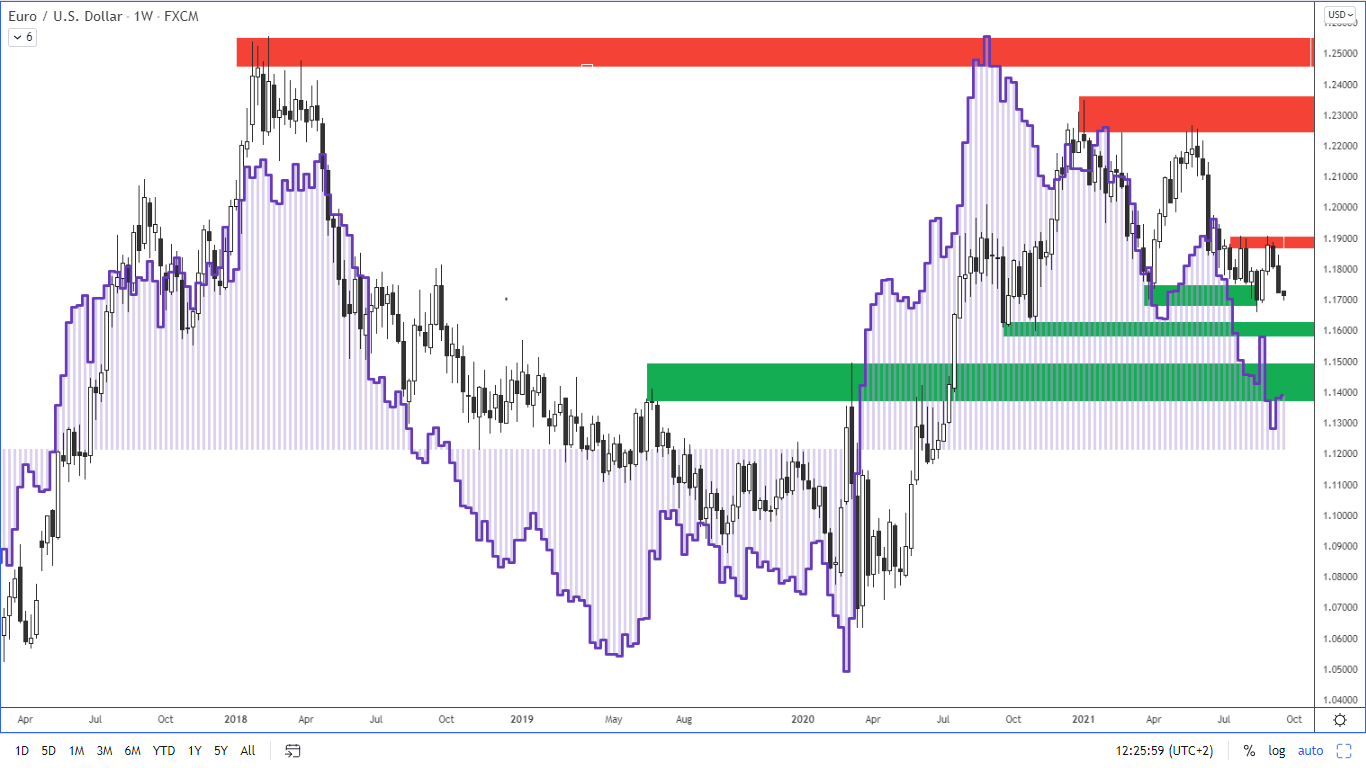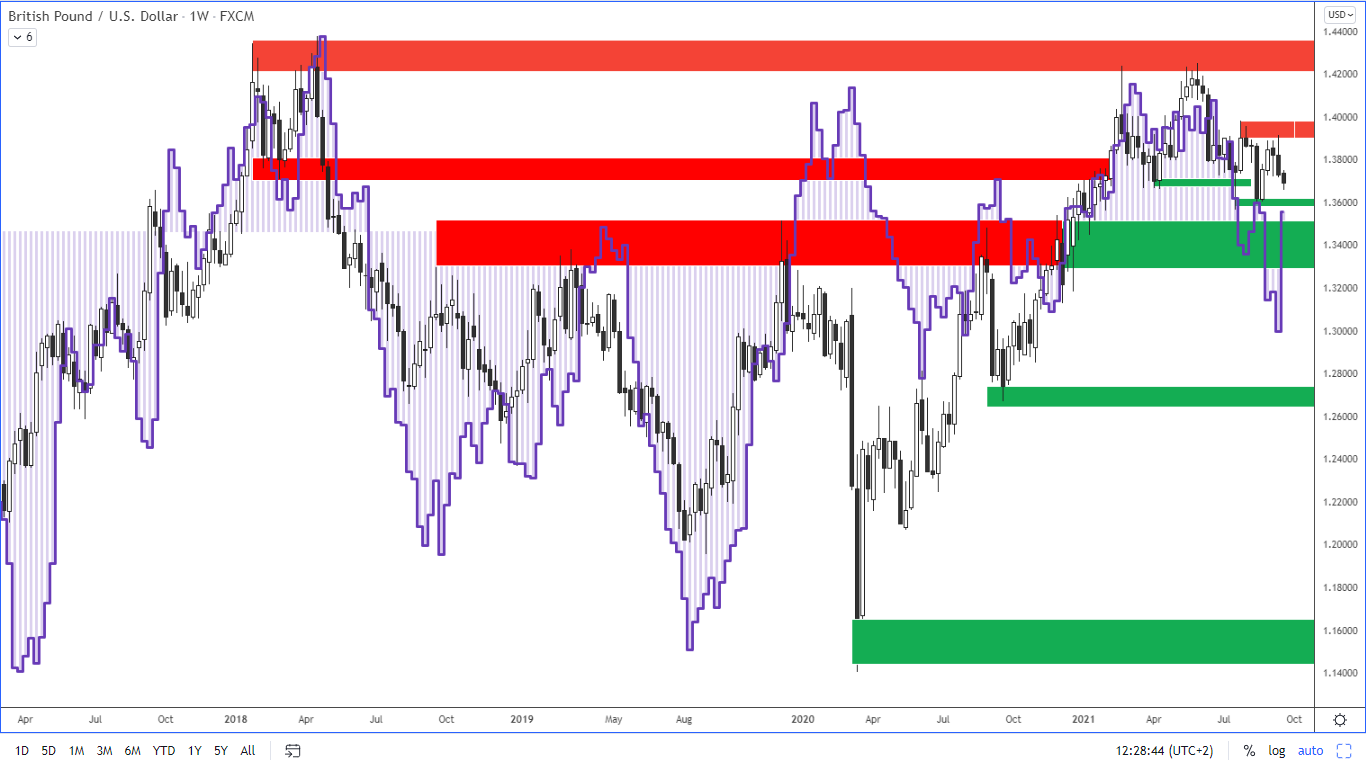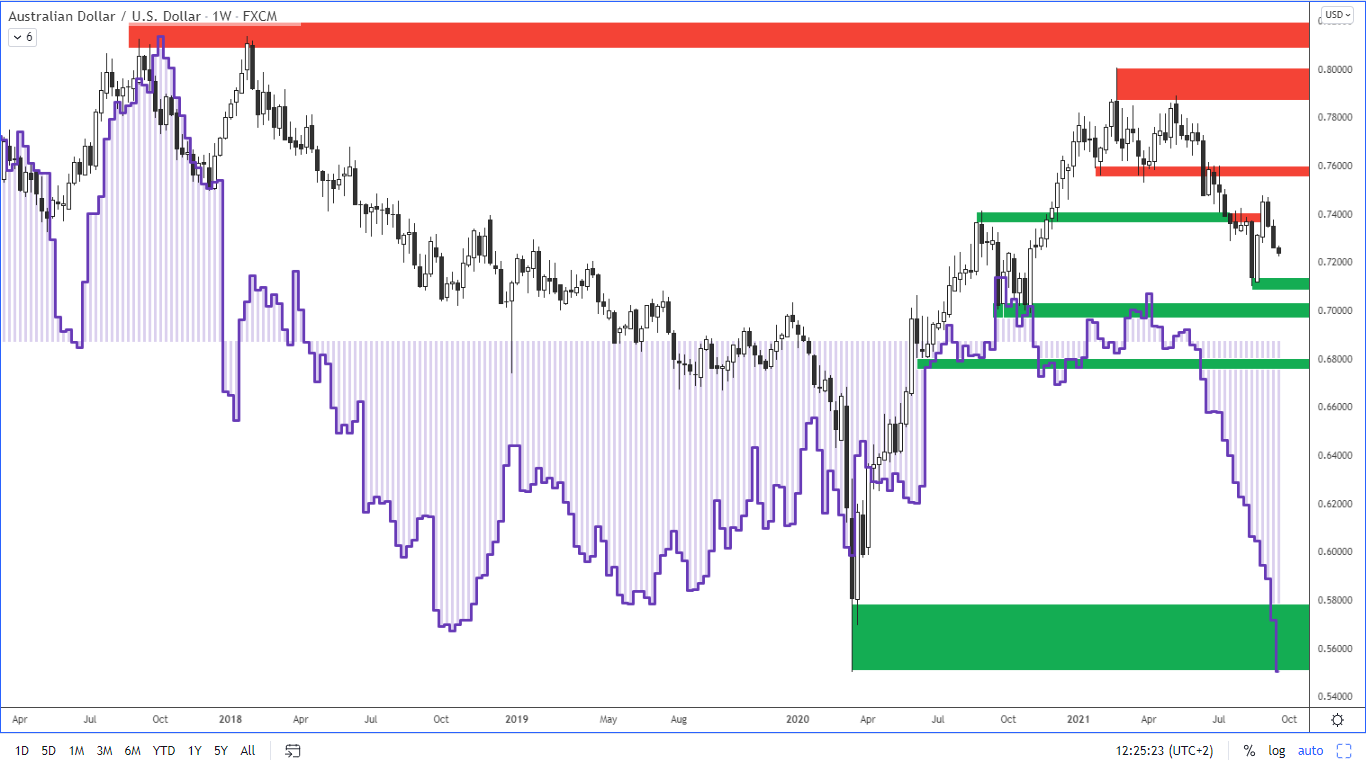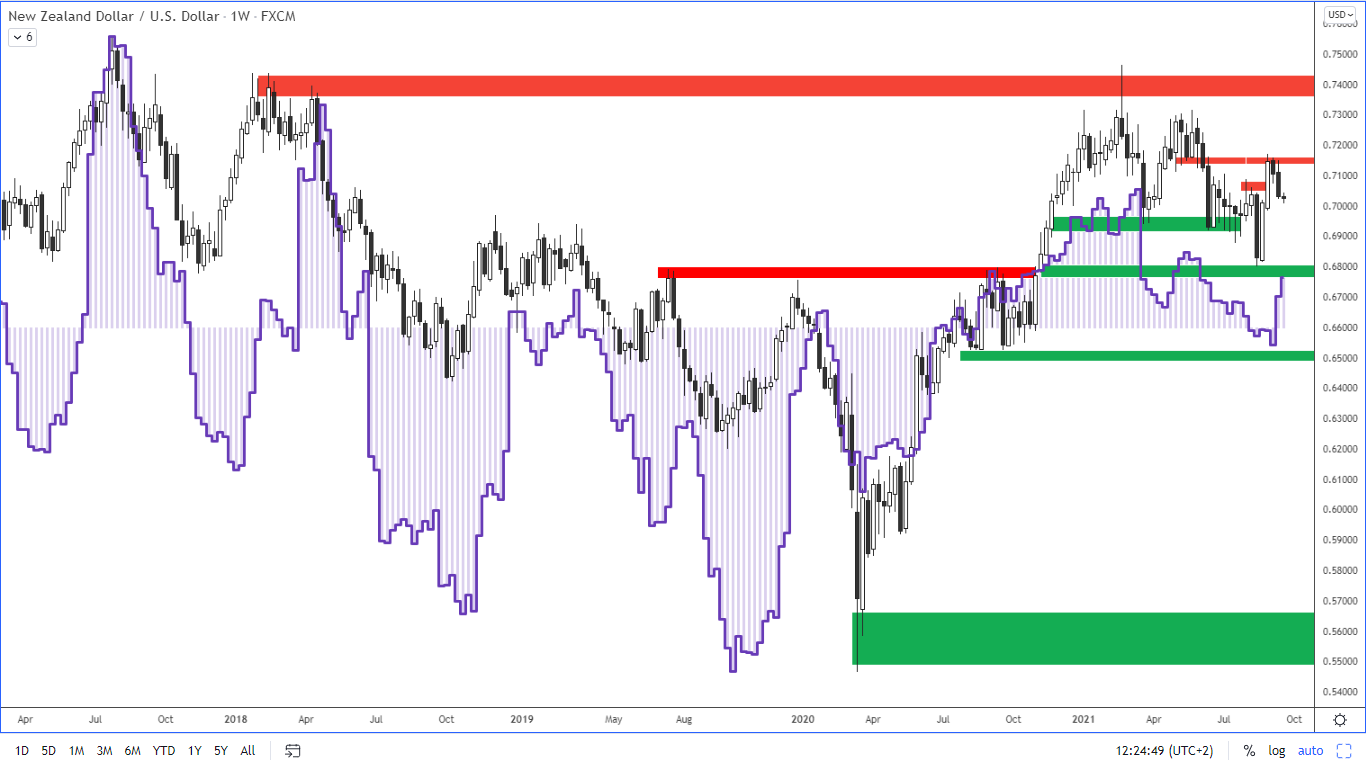Positions of large speculators according to the COT report as at 17/9/2021
Total net speculator positions in the USD index rose by 1,800 contracts last week. This change is the result of an increase in long positions by 1,700 contracts and a decrease in short positions by 1,100 contracts.
The increase in total net speculator positions occurred last week in the euro, the New Zealand dollar the British pound and the Japanese yen.
The decreases in total net positions occurred in the Australian dollar, the Swiss franc and the Canadian dollar.
Last week, the US equity indices experienced a correction. Following this, currencies weakened against the US dollar.
One of the reasons for the fall in global equities is the expected fall of a major Chinese developer, Evergrande, which may weigh on banks and the real estate segment in the Chinese economy, which is the world's second largest one. These concerns are then spilling over into weakening global equities and a strengthening of the US dollar.
This week, the Fed will decide on interest rates on Wednesday. They are expected to remain unchanged. The Fed's rhetoric on tapering the government bond purchases will be crucial. Investors expect this to happen sometimes this year. This is likely to be another reason for the US equities to weaken.
On Thursday, the Bank of England will decide on interest rates which will have an impact on the British pound.
The positions of speculators in individual currencies
The total net positions of large speculators are shown in Table 1: If the value is positive then the large speculators are net long. If the value is negative, the large speculators are net short.
|
|
17/9/2021
|
10/9/2021
|
3/9/2021
|
27/8/2021
|
20/8/2021
|
13/8/2021
|
|
USD index
|
24,300
|
21,500
|
20,700
|
20,400
|
19,200
|
19,300
|
|
EUR
|
27,800
|
26,300
|
10,500
|
24,600
|
57,600
|
33,900
|
|
GBP
|
4,800
|
-24,500
|
-14,900
|
-16,700
|
4,700
|
7,100
|
|
AUD
|
-83,400
|
-70,500
|
-60,100
|
-56,600
|
-50,400
|
-49,300
|
|
NZD
|
6,200
|
3,900
|
-2,100
|
-400
|
-200
|
-1,000
|
|
CAD
|
-9,300
|
-6,000
|
-2,800
|
5,900
|
2,700
|
6,500
|
|
CHF
|
-5,900
|
200
|
4,000
|
4,100
|
5,500
|
9,700
|
|
JPY
|
-60,300
|
-62,300
|
-63,100
|
-66,700
|
-63,200
|
-60,700
|
Table 1: Total net positions of large speculators
Notes:
Large speculators are traders who trade large volumes of futures contracts, which, if the set limits are met, must be reported to the Commodity Futures Trading Commission. Typically, this includes traders such as funds or large banks. These traders mostly focus on trading long-term trends and their goal is to make money on speculation with the instrument.
The total net positions of large speculators are the difference between the number of long contracts and the number of short contracts of large speculators. Positive value shows that large speculators are net long. Negative value shows that large speculators are net short. The data is published every Friday and is delayed because it shows the status on Tuesday of the week.
The total net positions of large speculators show the sentiment this group has in the market. A positive value of the total net positions of speculators indicates bullish sentiment, a negative value of total net positions indicates bearish sentiment.
When interpreting charts and values, it is important to follow the overall trend of total net positions. The turning points are also very important, i.e. the moments when the total net positions go from a positive value to a negative one and vice versa. Important are also extreme values of total net positions as they often serve as signals of a trend reversal.
Sentiment according to the reported positions of large players in futures markets is not immediately reflected in the movement of currency pairs. Therefore, information on sentiment is more likely to be used by traders who take longer trades and are willing to hold their positions for several weeks or even months.
Detailed analysis of selected currencies
Explanations:
Purple line and histogram in the chart window: this is information on the total net position of large speculators. This information shows the strength and sentiment of an ongoing trend.
Green line in the indicator window: these are the bullish positions of large speculators.
Red line in the indicator window: indicates the bearish positions of large speculators.
If there is a green line above the red line in the indicator window, then it means that the overall net positions are positive, i.e. that bullish sentiment prevails. If, on the other hand, the green line is below the red line, then bearish sentiment prevails and the overall net positions of the big speculators are negative.
Information on the positions of so-called hedgers is not shown in the chart, due to the fact that their main goal is not speculation, but hedging. Therefore, this group usually takes the opposite positions than the large speculators. For this reason, the positions of hedgers are inversely correlated with the movement of the price of the underlying asset. However, this inverse correlation shows the ongoing trend less clearly than the position of large speculators.
Charts are made with the use of www.tradingview.com.
Euro
|
Date
|
Weekly change in open interest
|
Weekly change in total net positions of speculators
|
Weekly change in total long positions of speculators
|
Weekly change in total short positions of speculators
|
Sentiment
|
| 17/9/2021 |
-43,600 |
1,500 |
-3,400 |
-4,900 |
Bullish |
| 10/9/2021 |
-8,400 |
15,800 |
-700 |
-16,500 |
Bullish |
| 3/9/2021 |
6,600 |
-14,100 |
-3,600 |
10,600 |
Weakening bullish |
 Figure 1: The euro and COT positions of large speculators on a weekly chart
Figure 1: The euro and COT positions of large speculators on a weekly chart
Total net speculator positions rose by 1,500 contracts last week. This change is due to a decrease in long positions by 3,400 contracts and a decrease in short positions by 4,900 contracts.
The price of the euro continued to weaken last week and approached the support around 1.17. After breaking it, a decline to 1.16 can be expected.
Long-term resistance: 1.1870 - 1.1900
Long term support: 1.1580 - 1.1620
The British pound
|
Date
|
Weekly change in open interest
|
Weekly change in total net positions of speculators
|
Weekly change in total long positions of speculators
|
Weekly change in total short positions of speculators
|
Sentiment
|
| 17/9/2021 |
-58,800 |
29,300 |
14,800 |
-14,500 |
Bullish |
| 10/9/2021 |
7,400 |
-9,600 |
-7,200 |
2,400 |
Bearish |
| 3/9/2021 |
-2,400 |
1,800 |
-2,900 |
-4,800 |
Bearish |
 Figure 2: The GBP and COT positions of large speculators on a weekly chart
Figure 2: The GBP and COT positions of large speculators on a weekly chart
Last week, the total net positions of speculators grew by 29,300 contracts. The change in total net positions over the past week is the result of a 14,800 contracts increase in long positions and a 14,500 contracts decrease in short positions.
The pound bounced off resistance levels against the US dollar last week and weakened quite significantly despite good labour market data and higher inflation. Volatility can be expected on the pound towards the end of the week as the UK central bank will decide on interest rates on Thursday.
Long-term resistance: 1.3900-1.3980
Long term support: 1.3570-1.3620
The Australian dollar
|
Date
|
Weekly change in open interest
|
Weekly change in total net positions of speculators
|
Weekly change in total long positions of speculators
|
Weekly change in total short positions of speculators
|
Sentiment
|
| 17/9/2021 |
-8,800 |
-12,900 |
-19,400 |
-6,500 |
Bearish |
| 10/9/2021 |
-8,600 |
-10,400 |
-14,900 |
-4,500 |
Bearish |
| 3/9/2021 |
-15,600 |
-3,500 |
-13,600 |
-10,100 |
Bearish |
 Figure 3: The AUD and COT positions of large speculators on a weekly chart
Figure 3: The AUD and COT positions of large speculators on a weekly chart
The increase in bearish sentiment on the Australian dollar continued to continue. Last week, speculators' total net positions fell by 12,900 contracts. This change is due to a 19,400 decline in long positions and a 6,500 contract decline in short positions.
The lockdown in Australia continues to have a negative effect on the Australian dollar. In addition, the slowing economy in China, which is a major trading partner for Australia, may have a negative impact on the Australlian dollar too.
Long-term resistance: 0.7560-0.7600
Long term support: 0.7100-0.7130
The New Zealand dollar
|
Date
|
Weekly change in open interest
|
Weekly change in total net positions of speculators
|
Weekly change in total long positions of speculators
|
Weekly change in total short positions of speculators
|
Sentiment
|
| 17/9/2021 |
-22,400 |
2,300 |
-2,500 |
-4,800 |
Bullish |
| 10/9/2021 |
9,800 |
6,000 |
2,400 |
-3,600 |
Bullish |
| 3/9/2021 |
1,900 |
-1,700 |
500 |
2,200 |
Bearish |
 Figure 4: The NZD and the position of large speculators on a weekly chart
Figure 4: The NZD and the position of large speculators on a weekly chart
Last week, total net positions rose by 2,300 contracts. This is the result of a decrease in long positions by 2,500 contracts and a decrease in short positions by 4,800 contracts.
The New Zealand dollar weakened along with other commodity currencies last week in line with risk-off sentiment.
Resistance: 0.7130-0.7160
Long term support: 0.6760-0.6800